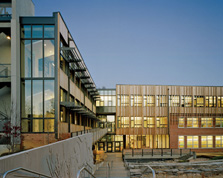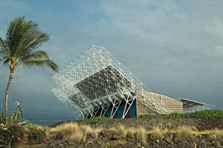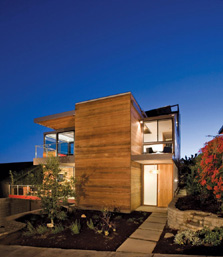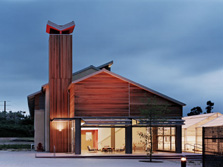

Sidwell Friends Middle School, Washington, D.C.
A pre-kindergarten through 12th grade school incorporates high-efficiency lighting, solar ventilation chimneys, and a PV array that generates 5% of the building's energy needs.
(Credit: Barry Halkin)

Hawaii Gateway Energy Center, Kailua-Kona, Hawaii
This visitor complex is designed as a thermal chimney, capturing heat and creating air movement using only building form and thermodynamic principles. A PV system provides all of the energy needed to run seawater pumps, lights, and other electrical equipment.
(Credit: Franzen Photography)

Z6 House, Santa Monica, California.
This single-family residence has no forced-air heating or cooling. The home has a passive cooling strategy that uses cross-ventilation and a thermal chimney. A 2.4-kW PV array is designed to provide up to 75% of the home's energy needs.
(Credit: CJ Berg Photographics/Sunshine Divis Photography)

Global Ecology Research Center, Stanford, California.
This building at Stanford University is an extremely low-energy laboratory and office building for the Carnegie Institution of Washington. Proper orientation, exceptional daylighting, sunshading, and natural ventilation set the stage for innovative mechanical systems.
(Credit: Peter Aaron/Esto Photographics)
Solar Decathlon 2007
The American Institute of Architects
The American Institute of Architects (AIA), a proud sponsor of the Solar Decathlon since its inception, is honored to support academic teams representing universities from around the world as they design and build innovative applications of solar power.
Creative problem solving is something the AIA and its 80,000 members know very well. For 150 years, AIA members have worked with each other and their communities to create more valuable, healthy, secure, and sustainable buildings and cityscapes.
The AIA seeks to dramatically increase the number of high-performance buildings constructed in the coming decades. Buildings account for an estimated 48% of all greenhouse emissions—compared to 27% for transportation. Seventy-six percent of all electricity generated by power plants goes toward operating buildings.
We believe architects are uniquely positioned to have a profound impact on energy usage. The AIA has adopted a position statement calling for the immediate energy reduction of all new and renovated buildings to one-half the national average for that building type, with increased reductions of 10% every five years. By 2035, it is our goal that all buildings designed will be carbon neutral, meaning they will use no fossil fuel energy.
Through our partnership with the U.S. Department of Energy and its Solar Decathlon program, we seek to demonstrate not just the critical connection between building design and energy conservation, but also to take one hopeful step in ensuring a lasting legacy for future generations.
The AIA/COTE (Committee on the Environment) Green Projects Awards recognize projects that address environmental challenges with designs that integrate architecture, technology, and natural systems. Some recipients of the 2007 honors are shown in the photos to the right.
